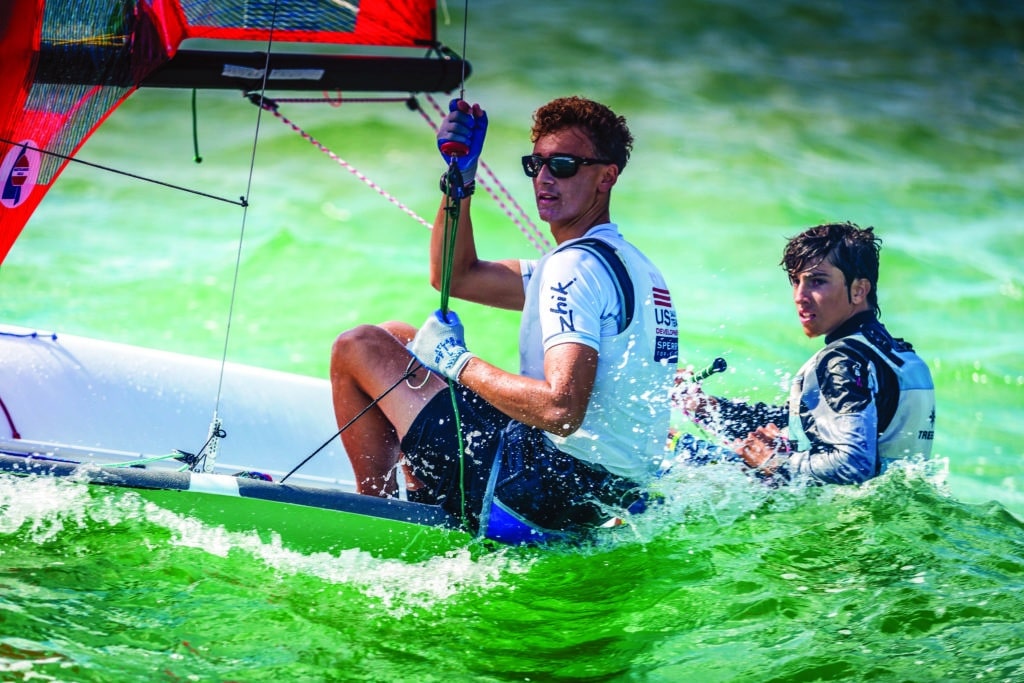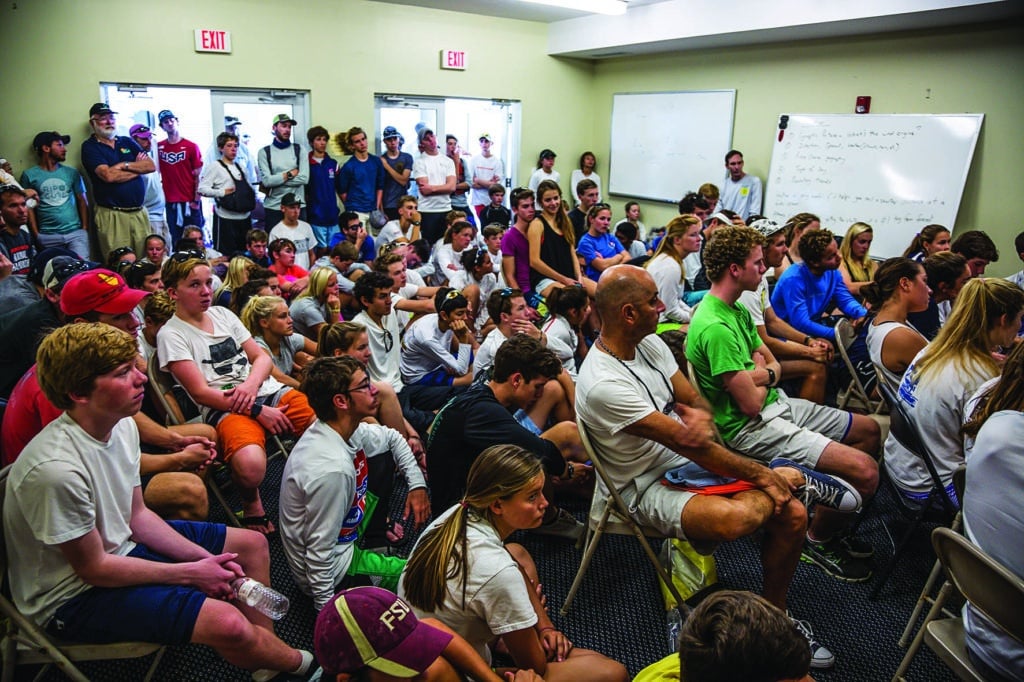
It usually takes a catastrophe to alert us to a problem. How many bridges must fall before we deal with our aging infrastructure? Will we deplete Social Security before we address the situation? Why is doing what’s needed always a priority once it’s too late? I might ask the same of our Olympic sailing efforts.
American sailing has a long history of Olympic domination: No country has won more total medals than the United States. We lead the count when it comes to silver and bronze medals. Only Great Britain holds more gold. Since 1932, American sailors have won medals in every Olympic regatta in which they’ve competed, but not in 2012. Getting skunked was inevitable. The warning signs were there, but it took a kick in the ass to prompt action.
Those warning signs were the result of good intentions. Youth sailing in the United States was organized like other youth sports, and sailing had become age-based, with sturdy institutional boats providing broad access. Better structure and coaching saw participation increase significantly. There was little to complain about, but there was a festering problem: “Sailors were learning more and more about less and less,” says Charlie McKee, US Sailing Team Sperry’s current high-performance director.
American sailors launching their respective Olympic campaigns, often after college, were ill-prepared. Development of Olympic boardsailing and catamaran athletes was virtually nonexistent, and dinghy sailors primarily sailed low-tech, low-performance boats. The young aspiring sailors were well traveled, having crisscrossed the country to compete in the popular youth events, but they were only being challenged by competitors their own age. They lacked the experience and skill needed to sail at the Olympic level.
It hadn’t always been that way. McKee, a double Olympic medalist, was aging out of youth sailing when the structure was being formed. He considered the diversity of his background to be an asset. “We sailed all kinds of boats, whatever we could get our hands on,” he says. “But also, when I was a kid, I never won at sailing because I raced a lot more against adults. I was lucky the people that were a little bit older than me were very, very good sailors. I wasn’t going to beat Carl Buchan, or Craig Thomas, or my brother Jonathan, but I kept after it because I loved it and wanted to learn and improve.”
The long-term effect of hyperorganized youth sailing was a slow burn on the Olympic program. After some hugely successful Games, the final haul was in Sydney in 2000, with four medals. The US Sailing team netted two medals in 2004 and 2008, respectively, but the sailors were older, most events had no depth, and there wasn’t enough funding or time to groom new campaigners for the podium.
It’s easy to peg this situation entirely on funding, or the perceived lack thereof, but doing so wouldn’t tell the whole story. Yes, the US Sailing team’s budget wasn’t on par with other national sailing programs, but plenty of money was spent grooming young sailors before they began Olympic campaigns. It just wasn’t spent very well to prepare them for their campaigns. And once young sailors did commit to an Olympic campaign, most parents had closed the checkbook. They had already paid plenty for coaches, clinics and competitions. Without start-up support, talented kids either turned to pro sailing or tapped out altogether.
Getting skunked in Weymouth, however, was critical for the U.S. Olympic sailing program. The first step in solving a problem is admitting there is one, right? Before, the problem was only discussed in whispers. Those deeply involved in youth sailing felt their efforts were being admonished for their effect on the “1 percent” of Olympic sailing. They weren’t wrong, but still, the solution was for the elite youth sailors to seek higher ground.
The single most important accomplishment of the current Olympic quad, therefore, is that this topic is now in the open. But that’s only a start. At this point, the key to progress is to do the very best at preparing those sailors already vested for the Rio Games, but then to work like mad to find gems within the youth ranks for 2020 and beyond.

Funding, however, is still an issue. The U.S. program has had to reach down into the youth ranks and raise its overall quality. An investment had to be made, with young sailors training in the right boats with the right instruction. While this initiative started before the 2012 Games, the medal shutout prompted critical funding to accelerate the initiative. Known as the Olympic Development Program, it has positive early metrics.
“There were strong results from the sailors in 2015,” says Josh Adams, Managing Director of U.S. Olympic Sailing. “They deserve a lot of credit because they have been working really hard with their own coaches in addition to working with the ODP.”
He cites Christopher Williford and Wade Waddell, who won bronze at the 29er Worlds; Nic Baird, who won bronze at the Laser Radial Youth Worlds; and Wiley Rogers and Jack Parkin, 420 European champions (with Will Logue and Bram Brakman finishing second).
While the future appears to be improving, prepare for the medal count at the Rio Games to be underwhelming. “We only have a few medal prospects for Rio, and nobody is a favorite to win a medal,” says McKee. “One medal would be great, but does zero medals or one medal really change where we are? Not really, but we are on the right track, longer-term.”
Some of our sailors are looking at 2020 or 2024, he adds. “We have a young team, and we know we’ll have people in Rio that aren’t yet in contention, but if we help them as much as we can and make Rio a positive experience, then it can be the springboard.”
Unlike many countries that have subjective selection series, and which may send only those athletes who can contend for a medal, the U.S. selection system is points-based and obligated to send sailors who qualify. The selection series results may reflect the outcome in Rio, but for the U.S. program to improve, the bulk of the Rio team must continue with another campaign for 2020. The wave of new athletes behind them must increase in number and be supported financially.
The development of future Olympians currently lies in the hands of Leandro Spina, US Sailing’s youth development director. “We are really excited now about our ability to reach out to the young talent and support them,” he says. “We are working together with the talent, with the coaches, with the programs, with the yacht clubs.”
He does have all the pieces to succeed, he says, but he also needs to “go out and put it all together.”
I do not stand beside those who dispute the importance of Olympic sailing in our sport, because the Olympic regatta is, without argument, our pinnacle event. I once tried a campaign myself, and have great appreciation for the opportunities it gave me. The Games give dreamers a purpose. My era, however, was one that basked in success, so I am eager for American sailing to return to its former glory. We are fortunate the 2012 team whiffed, because from failure came hope for those now on the path.









